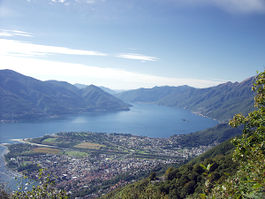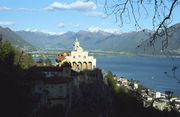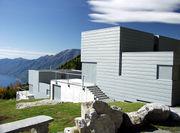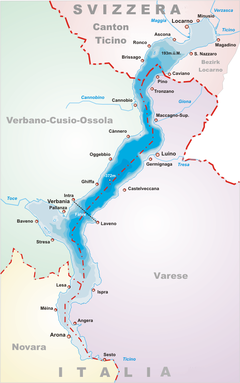Locarno
| Locarno | ||||||||||
|---|---|---|---|---|---|---|---|---|---|---|
 |
||||||||||
|
||||||||||
| Population | 15,185 (Dec 2009)[1] | |||||||||
| - Density | 783 /km2 (2,027 /sq mi) | |||||||||
| Area | 19.4 km2 (7.5 sq mi) | |||||||||
| Elevation | 200 m (656 ft) | |||||||||
| Postal code | 6600 | |||||||||
| SFOS number | 5113 | |||||||||
| Mayor | Carla Speziali | |||||||||
| Surrounded by | Ascona, Avegno, Cadenazzo, Contone, Cugnasco, Gerra (Verzasca), Gordola, Lavertezzo, Losone, Magadino, Minusio, Muralto, Orselina, Piazzogna, San Nazzaro, Tegna, Tenero-Contra | |||||||||
| Website | www.locarno.ch Profile (Italian), SFSO statistics |
|||||||||
 Locarno
|
||||||||||
| View map of Locarno | ||||||||||
Locarno (Latin: Leocarnum; literally: "Lion's Flesh") is the capital of the Locarno district, located on the northern tip of Lake Maggiore (Lago Maggiore) in the Swiss canton of Ticino, close to Ascona at the foot of the Alps. It has a population of about 15,000[2] (60'000 for the urban area including Ascona). The official language of Locarno is Italian. It is the 74th biggest city in Switzerland by population and the 3rd biggest of the canton Ticino, after Lugano and Bellinzona.
An important film festival, the Locarno International Film Festival, takes place every year in August in the Piazza Grande.
The Locarno Treaties were negotiated here in 1925.
In January 2004, the Italian historian Marino Vigano speculated that Locarno's castle may have been designed by Leonardo da Vinci.
Contents |
Main sights


Locarno has a number of interesting sights that draw tourists year-round.
Astrovia Locarno
The Astrovia Locarno is a 1 : 1,000,000,000 scale model of the Solar System. The Sun can be found at the end of Via Gioacchino Respini where the cycle path, which runs alongside the river, starts. Pluto, the final planet in the model, can be found 6 km away from this starting point in the village of Tegna.
Madonna del Sasso, Cardada and Cimetta
The sanctuary of Madonna del Sasso in Orselina above the city is the principal sight and goal of pilgrimage in the city.
The founding of the sanctuary goes back to a vision of the Virgin Mary that the Franciscan brother Bartolomeo d'Ivrea experienced in the night of 14/15 August 1480. The interior is highly decorated, and a platform gives a magnificent view of the city.
A gondola runs from Orselina to the top of Cardada (el. 1,340 m (4,396 ft)), and a chair lift goes further to the top of Cimetta (el. 1,671 m (5,482 ft)).
Castello Visconteo
Castello Visconteo on the edge of the old town was built in the 12th century, probably as the residence of a Captain Orelli, who remained true to the Emperor. In 1260, it fell into the hands of the Ghibellines. In 1342 the Visconti of Milan, for whom it is now named, attacked the castle from both the land and the lake side and took it. It first came into the hands of the Eidgenossen in 1503. Today, only a fifth of the original structure remains. Most of that dates from the 15th and 16th centuries. Only the foundation remains from the original structure.
Weather
| Climate data for Locarno/Monti | |||||||||||||
|---|---|---|---|---|---|---|---|---|---|---|---|---|---|
| Month | Jan | Feb | Mar | Apr | May | Jun | Jul | Aug | Sep | Oct | Nov | Dec | Year |
| Source: MeteoSchweiz [3] | |||||||||||||
References
- ↑ Swiss Federal Statistical Office, MS Excel document – Bilanz der ständigen Wohnbevölkerung nach Kantonen, Bezirken und Gemeinden (German) accessed 25 August 2010
- ↑ Bundesamt fur Statistik (Federal Department of Statistics) (2008). "Bilanz der ständigen Wohnbevölkerung (Total) nach Bezirken und Gemeinden". http://www.bfs.admin.ch/bfs/portal/de/index/themen/01/02/blank/key/raeumliche_verteilung/kantone__gemeinden.html. Retrieved November 5, 2008.
- ↑ "Temperature and Percipitation Average Values-Table, 1961-1990" (in German, French, Italian). Federal Office of Meteorology and Climatology MeteoSwiss. http://www.meteoswiss.admin.ch/web/de/klima/klima_schweiz/tabellen.html. Retrieved 8 May 2009.
- This article incorporates information from the German Wikipedia.
See also
External links
|
||||||||||||||||||||||||||
|
|||||||

